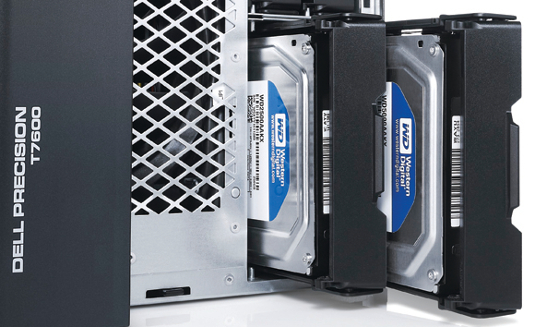Why you can trust Creative Bloq
PRICE: £5,953
Specification:
- 2 x 3.1GHz Intel Xeon E5-2687W processors
- 16GB PC3-1600 DDR3 RAM
- AMD FirePro V7900 graphics with 2GB GDDR5 memory
- 146GB Seagate Savvio 15K.3 15,000rpm SAS hard disk
- 2 x 600MB Seagate Savvio 10K.6 hard disk drives
- Gigabit Ethernet networking
- Windows 7 Pro 64-bit
- 3 years NBD onsite warranty
DEVELOPER: Dell
Dell’s Precision Workstations have traditionally been rather sober affairs, which isn’t necessarily a bad thing in a system used for work. But the T7600 shows a little more flair. Each end of the chassis is home to sturdy asymmetrical handles, which make it extremely easy to move this heavy, solidly built workstation around your studio. But there’s more to the T7600 than just funky chassis design.
Inside, there’s a pair of Intel Xeon E5-2687W processors. We’ve seen quite a few systems with these powerful 3.1GHz eight-core CPUs, and they are still the most potent option for a workstation. They support Intel Hyper-Threading, so each physical core is detected as two virtual ones, meaning the T7600 has a whopping 32 virtual processing cores on offer. The processors support Intel Turbo Boost, too, allowing a single core to be increased to 3.8GHz, and all cores to 3.4GHz for limited periods. Partnering the twin CPUs is a reasonably healthy 16GB of 1,600MHz DDR3 memory, supplied as four 4GB DIMMs, leaving 12 slots free for upgrade to a maximum of 256GB.

Dell has opted for AMD graphics, in the shape of a FirePro V7900. This is a capable graphics card, with 1,280 stream processors and 2GB of GDDR5 memory. However, AMD has trumped the V7900’s generation with the W8000 and W9000; and, as we discovered in our review last issue, Nvidia’s latest Quadro K5000 is a league ahead. So it’s worth bearing in mind there are a number of more powerful alternatives on the market now.
Dell Precision Workstation T7600 Advanced: storage
Storage is very much industrial-strength, with the main capacity provided by three SAS disks. Instead of supplying a solid-state disk as the boot drive, Dell has opted for a 146GB Seagate Savvio 15K.3 hard disk. This has a 15,000rpm rotational speed, however, so it will offer pretty good performance. The 15K.3 is partnered by two 600GB Seagate Savvio 10K.6 hard disks, which are 10,000rpm models, although they are merely configured as two separate disks. The SAS disks do add a lot to the price of the system, but they will also be very quick and reliable. Despite the size of the workstation, Dell has chosen to supply a slimline Philips-LiteON DS-8D3SH notebook optical drive, which is only capable of 8x DVD rewriting.
Dell Precision Workstation T7600 Advanced: Performance
With the T7600 sporting the fastest workstation processors currently available, the Maxon Cinebench R11.5 rendering score of 24.72 is unsurprisingly stunning. It’s slightly less than some similarly specified Xeon workstations we’ve tested, but not by enough to be a worry.
The OpenGL score of 76.87 is also quick, but we’ve seen better results.
In SPECviewperf 11, though, the T7600 achieves a merely respectable score of 55.86 in the lightwave-01 viewset, and a decent SolidWorks sw-02 result of 49.63. Both are noticeably behind AMD’s FirePro W8000 or Nvidia K5000.
The maya-03 score of 36.07 is quite a bit lower than what systems sporting similarly priced Nvidia Quadro cards can muster.
So the T7600 has excellent rendering abilities, but it could do with the latest graphics to make its modelling abilities on a par with the most cutting edge workstations. Coming in at just under £6,000, the Precision Workstation T7600 is also a little pricey, when you consider that similarly powerful workstations can be had for under £5,000. Nevertheless, this is still a reassuringly solid workstation.
PROS
- Great chassis design and build
- Excellent rendering performance
- Fast SAS storage
CONS
- A little expensive
- AMD FirePro V7900 graphics behind latest offerings
A solidly built workstation with design flair and decent graphics performance, but it’s a little pricey thanks to the SAS hard disks
RATING: 4
About the author
James Morris has tracked the rise of every new development, from OpenGL accelerators to multiprocessor workstations, over more than 15 years of testing 3D content-creation hardware

Thank you for reading 5 articles this month* Join now for unlimited access
Enjoy your first month for just £1 / $1 / €1
*Read 5 free articles per month without a subscription

Join now for unlimited access
Try first month for just £1 / $1 / €1

The Creative Bloq team is made up of a group of art and design enthusiasts, and has changed and evolved since Creative Bloq began back in 2012. The current website team consists of eight full-time members of staff: Editor Georgia Coggan, Deputy Editor Rosie Hilder, Ecommerce Editor Beren Neale, Senior News Editor Daniel Piper, Editor, Digital Art and 3D Ian Dean, Tech Reviews Editor Erlingur Einarsson, Ecommerce Writer Beth Nicholls and Staff Writer Natalie Fear, as well as a roster of freelancers from around the world. The ImagineFX magazine team also pitch in, ensuring that content from leading digital art publication ImagineFX is represented on Creative Bloq.
